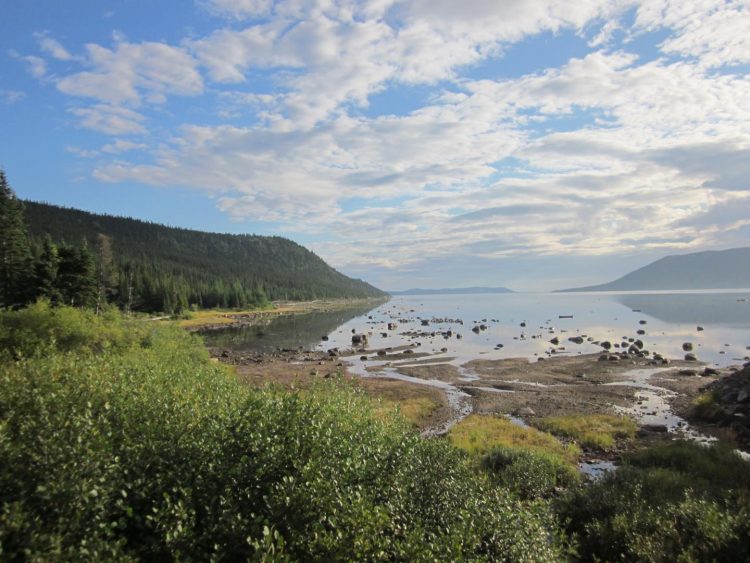Poison in the Arctic and the human cost of 'clean' energy

Rigolet is on the shore of Lake Melville. Credit: Prentiss Balcom
Methylmercury, a potent neurotoxin, is especially high in Arctic marine life but until recently, scientists haven't been able to explain why. Now, research from the Harvard John A. Paulson School of Engineering and Applied Science (SEAS) and Harvard T.H. Chan School of Public Health suggests that high levels of methylmercury in Arctic life are a byproduct of global warming and the melting of sea-ice in Arctic and sub-Arctic regions.
To mitigate global warming, many governments are turning to hydroelectric power but the research also suggests that flooding for hydroelectric development will put even more methylmercury into ecosystems than climate change.
The research, published in PNAS, began as a review of the environmental impact assessment for the Muskrat Falls hydroelectric dam in Labrador, Canada, which, in 2017, will flood a large region upstream from an estuarine fjord called Lake Melville. The majority of the lake lies in Nunatsiavut, the first autonomous region in Canada governed by Inuit. The predominantly indigenous communities along Lake Melville rely on the lake as a primary source of food.
When an impact report predicted no adverse downstream effects into Lake Melville from the flooding, the Nunatsiavut Government reached out to Elsie Sunderland, associate professor of environmental engineering at SEAS and environmental health at the Harvard Chan School, for help.
“Clean energy benefits the entire world but the costs of hydroelectric power are often assumed entirely by the Aboriginal communities who live next to these developments,” said Sunderland. “Our research highlights some of the costs to the community with the goal of helping them plan and adapt to the changes that are about to occur.”
Sunderland and her team — including lab manager Prentiss Balcom and postdoctoral fellow Amina Schartup, the paper's first author — made their first trip to Lake Melville in 2012. They collected baseline methylmercury levels on a fishing boat called “What's Happening” — which was exactly the question Sunderland and her team asked when the results came in.
“We found more methylmercury in the water than our modeling could explain,” said Schartup. “All of the methylmercury from the rivers feeding into Lake Melville and from the sediment at the bottom of the lake couldn't account for the levels in the water. There was something else going on here.”
The team noted that the concentration of methylmercury in biota — the plankton –peaked between 1 and 10 meters below the surface.
These findings closely matched findings from the central Arctic Ocean. The question was, why was there such a high concentration of methylmercury in biota in both systems?
The answer lay in the eating habits of plankton.
When fresh and salt water meet– in estuaries or when sea-ice melts in the ocean– salinity increases as water deepens. This stratification allows fluffy organic matter that typically sinks to the bottom to reach a neutral buoyancy — meaning it can't float up or down in the water column. This layer, called marine snow, collects other small settling debris and concentrates it into a feeding zone for marine plankton. The bacteria stuck in this zone are performing a complex chemical process that turns naturally occurring mercury into deadly and readily accumulated methylmercury.
Attracted to this layer of marine snow, the zooplankton go on a feeding frenzy that can last several weeks. In this time, methylmercury produced by the bacteria accumulates in biota and magnifies as it works its way up the food chain.
“This system is incredibly efficient at accumulating methylmercury,” said Schartup.
This same system can be extrapolated to the Arctic, where freshwater from melting ice is mixing with salt water, Schartup said.
If this system is already a pro at magnifying methylmercury, what happens when methylmercury levels increase due to reservoir flooding upstream?
Sunderland and her team collected soil cores from the inland areas that are slated to be flooded for hydroelectric power in 2017. The team simulated flooding by covering the cores with river water. Within five days, methylmercury levels in the water covering the cores increased 14 fold. Estimated increases in methylmercury inputs from the Churchill River resulting from this pulse of methylmercury range from 25 to 200 percent.
That's the low estimate.
“We removed the litter layer and surface vegetation prior to saturating the cores, which is known to decrease methylmercury levels, ” Sunderland said. “Without clearing that, the actual pulse of methlymercury to the Lake Melville ecosystem may be much greater.”
For communities who rely on the ecosystem for food, like those along Lake Melville, the downstream effects of flooding for hydroelectric development could be devastating.
“Scientists have a responsibility to understand and explain how environmental systems will react before they are modified,” Schartup said. “Because once the damage is done, you can't take it back.”
Media Contact
All latest news from the category: Earth Sciences
Earth Sciences (also referred to as Geosciences), which deals with basic issues surrounding our planet, plays a vital role in the area of energy and raw materials supply.
Earth Sciences comprises subjects such as geology, geography, geological informatics, paleontology, mineralogy, petrography, crystallography, geophysics, geodesy, glaciology, cartography, photogrammetry, meteorology and seismology, early-warning systems, earthquake research and polar research.
Newest articles

First-of-its-kind study uses remote sensing to monitor plastic debris in rivers and lakes
Remote sensing creates a cost-effective solution to monitoring plastic pollution. A first-of-its-kind study from researchers at the University of Minnesota Twin Cities shows how remote sensing can help monitor and…

Laser-based artificial neuron mimics nerve cell functions at lightning speed
With a processing speed a billion times faster than nature, chip-based laser neuron could help advance AI tasks such as pattern recognition and sequence prediction. Researchers have developed a laser-based…

Optimising the processing of plastic waste
Just one look in the yellow bin reveals a colourful jumble of different types of plastic. However, the purer and more uniform plastic waste is, the easier it is to…



